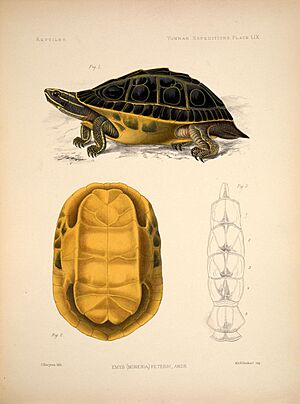Indian eyed turtle facts for kids
The Indian eyed turtle (Morenia petersi) is a special kind of turtle. It belongs to the Geoemydidae family. This turtle is only found in South Asia.
Quick facts for kids Indian eyed turtle |
|
|---|---|
 |
|
| Illustration of Morenia petersi | |
| Conservation status | |
| Scientific classification | |
| Genus: |
Morenia
|
| Species: |
petersi
|
| Synonyms | |
|
|
Contents
Where It Lives
You can find the Indian eyed turtle in northeastern India. It lives as far west as the state of Bihar. It also lives in Bangladesh.
Why Is It Called That?
The second part of the turtle's scientific name, petersi, honors a German scientist. His name was Wilhelm Peters. He studied reptiles and amphibians, which is called herpetology.
What It Looks Like
The Indian eyed turtle looks a lot like another turtle called Morenia ocellata. Its snout (nose area) is quite pointed and longer.
Shell and Markings
The top shell, called the carapace, is black. Each scute (plate) on its back has a thin yellowish line in the middle. The last four scutes have a yellow line shaped like a horseshoe. Both ends of this horseshoe point forward.
Each side scute has a low "eye-spot" or ocellus. This spot is a thin yellowish line. Above it are some wavy lines of the same color. The scute near its neck and each edge scute have a thin, vertical yellowish stripe. The bottom shell, called the plastron, is yellow.
Head Markings
There are three yellow stripes on each side of its head. The lowest stripe goes from below its nostril to the corner of its mouth.
Size
Male Indian eyed turtles can grow up to 5 inches (about 12 cm) long. Females can grow larger, reaching up to 8 inches (about 20 cm) in shell length.
Reproduction
Indian eyed turtles mate during the winter months. They lay their eggs in April or May. A female turtle usually lays two eggs at a time. Each egg is about 34.6–35 mm (1.4 inches) long and 22 mm (0.9 inches) wide.


